
Not actually our house. This one belongs to a family a couple of blocks from us called, I think, the Griswolds. As with most of my photos, click on the picture to see a larger version.

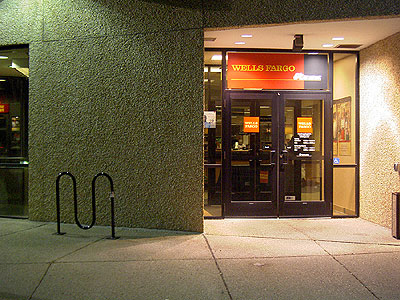











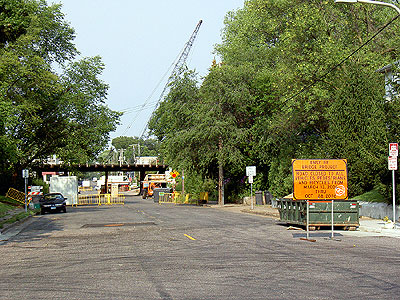
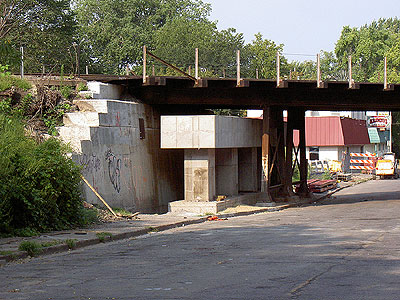





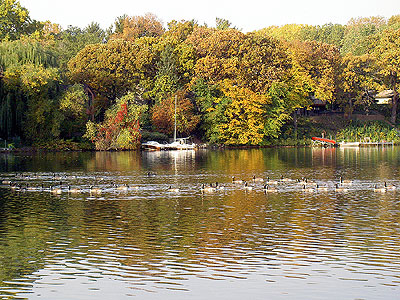
We have the bikes, here come the trails
With more paths and a conference Wednesday, St. Paul aims to become state's bicycling capital
BY JASON HOPPIN
Pioneer Press
As bicycle commuters go, Steve Scholl is among the hardest of the hard core.
Nothing stops him from biking from his home in St. Paul's Highland Park to his job downtown at the Department of Employment and Economic Development.
Nothing. Not traffic, not even the most daunting of Minnesota obstacles — winter.
"Ten years ago, 15 years ago, it was really difficult," Scholl said. "Today, I think it's really easy."
With varying levels of success, St. Paul has tried to become more bicycle-friendly.
But in the next few years, an unprecedented level of public investment — millions of dollars, much of it from federal funds — in bicycle infrastructure will at least bring St. Paul's reputation closer to that of Minneapolis, widely regarded as a national leader.
For Scholl, it means something as simple as the city plowing his bike route, the Shepard Road trail, during winter. But a vast expansion of the city's trail networks now under way would eventually allow bicyclists to cross town without sharing so much as an inch of pavement with automobiles.
The developments come as the city prepares for its first Bicycling Summit on Wednesday at Dunning Recreation Center. Together with an online survey, the conference will form the basis of a bicycle transportation plan that will be added to the city's overall plans.
"Mayor (Chris) Coleman is trying to make the city of St. Paul one of the most livable cities in America, and having trails and opportunities for cyclists is critical to making the city more livable," said Anne Hunt, Coleman's deputy policy director.
"What makes a great urban city is that you have opportunities to bike or walk or get in your automobile or use mass transit," Hunt said. "You want to provide residents and business people a variety of transportation options."
NOT JUST FOR HEALTH
The Twin Cities have a reputation as a bicycling mecca, but St. Paul has always lagged behind its neighbor. In the 2000 census, 2 percent of Minneapolis residents reported commuting to work by bicycle, third highest in the country for a city of that size. St. Paul came in at a third of that rate, 0.7 percent.
But the census is taken in March, typically a miserable month for weather in Minnesota. And the top two finishers, Tucson, Ariz., and San Francisco, are fair-weather cities year-round.
"It says something about the activity level here — a lot about the activity level here," said Bob Works, who heads the bicycle and pedestrian program for the Minnesota Department of Transportation.
Demonstrating the area's love for biking was this weekend's 12th annual St. Paul Classic Bike Tour, for which 7,000 cyclists registered to ride, including Coleman. It is the biggest bike tour in the state.
And there are anecdotal reports that many more people are hitting the roads on their bikes daily, driven largely by health-awareness campaigns and the cost of gasoline.
"It sure seems like there's been an increase in the number of cyclists in Minneapolis and St. Paul," said Steve Clark, bicycle- and pedestrian-program manager for Transit for Livable Communities, a nonprofit organization that oversees a $25 million pilot project to improve bicycle infrastructure and awareness, one of four such federally funded projects in the country.
"It's not just gas prices and climate change, but also health consciousness," Clark said.
And that may be one of the factors pushing St. Paul trail projects — more people than ever are using them.
One of the biggest projects is the extension of the Midtown Greenway into St. Paul. By putting a dedicated bike lane alongside the railroad bridge near St. Anthony Avenue, the project would create the second Twin Cities Mississippi River crossing exclusive to bikes and pedestrians (the Stone Arch Bridge is the first).
Eventually, the Greenway extension would connect to a new trail along Ayd Mill Road, which connects to the Interstate 35E bike route, which connects to the Dakota County Big River Trail.
ADDING CONVENIENCE
And that's the point — connectivity. Once a series of interconnected projects is completed, cyclists will be able to:
• Pedal from an afternoon concert on Harriet Island to Minneapolis' Uptown neighborhood for dinner while staying off streets altogether.
• Travel from the University of Minnesota to the Capitol, helped by new trails in Como Park and a bike lane along Como Avenue.
• Bike from Lowertown to, well, Duluth, if you're motivated enough, via an extension of the Bruce Vento Regional Trail in the works that will connect downtown to the Bruce Vento Nature Sanctuary and a series of regional and state trails.
Furthermore, while Summit Avenue was one of the first streets in the metro area with a bike lane, Minnehaha, Como, Marshall and Fairview avenues and others now have striped bike lanes. And more are coming.
It's a far cry from St. Paul's ill-fated 1995 foray into bicycle utopia. With much fanfare, the city introduced dozens of communal yellow bikes for the citizenry to jaunt about town.
It was a harsh lesson for idealists pushing alternative modes of transportation. Within days, they started showing up mangled and vandalized. Others just disappeared.
Other ideas have emerged since then. In mid-2004, Metro Transit finished putting bike racks on every bus. Trains on the Hiawatha light-rail line also have racks, as will trains planned for the Central Corridor. Metro Transit's Bob Gibbons said they've helped people get out of their cars, especially with the recent spike in gas prices.
"Anecdotally, our bus drivers tell us they've seen a big increase" in the number of bikes, Gibbons said.
Bicycle backers say it has taken a major change in mind-set to get street engineers, for example, to think beyond the automobile. But it is happening. The city's parks department and its public works department now work bikes into their plans. When Marshall Avenue was recently repaved, for example, a bike lane was added.
St. Paul Parks and Recreation Director Bob Bierscheid said the health and welfare of residents are part of his responsibilities, and biking opportunities are one way to address that.
"We've got this obesity issue that we're dealing with, and it's getting worse, not better," said Bierscheid, an avid cyclist. "We've got to get people out and active."
People who have toiled in grass-roots efforts to see these kinds of improvements say things have changed since the old days. Political leaders are more willing to back the projects as assets — not only to residents, but also to business leaders looking to locate a new shop or factory.
"I think the opportunities have gotten better and the climate has gotten better," said Richard Arey, a founder of both St. Paul's bicycle advisory board and the St. Paul Classic. "It does take a certain amount of self-enlightenment, but it does work."
Jason Hoppin can be reached at jhoppin@pioneerpress.com or 651-292-1892.
If you go:
What: St. Paul Bicycling Summit
When: 7 to 9 p.m. Wednesday
Where: Dunning Recreation Center, 1221 Marshall Ave.
Cycling enthusiasts can expect to see prices head uphill for bikes made of in-demand specialty materials such as titanium and carbon fiber.
Driving the increase is a sharp rise in orders for airplanes made of the same materials, meaning that bike makers -- along with makers of sailboats, lacrosse sticks, tennis rackets, jewelry and bone screws -- are paying 25% more for raw materials and passing along some of the costs to consumers.
Prices for high-end bikes from makers such as Trek Bicycle Corp., Cannondale Bicycle Corp., and Serotta Competition Bicycles, some of which already cost more than $10,000, could rise 5% to 25%. A custom-made La Corsa titanium frame from Serotta, for instance, would sell for up to $7,000 with top components by the end of this year, up from $6,000 in January.
Amid rising demand, titanium and carbon-fiber makers are largely catering to their bigger customers: the aerospace industry. Zsolt Rumy, chief executive of St. Louis-based Carbon Fiber maker Zoltek Companies Inc., says he is trying to keep prices lower for bigger customers by raising prices for smaller ones, such as bike and golf-club makers, who constitute 15% of his company's business. "We really jack up the price" for smaller customers, he says. He's passed on more of the 60% to 100% increases to sporting-goods customers.
Titanium makers say their silvery gray product, made by refining and melting an ore extracted from rutile sand found in Australia and elsewhere, has the strength of steel and the light weight of aluminum. But it's far more expensive than both: Titanium can cost more than $32,000 a ton, compared with less than $1,000 a ton for carbon steel. The price of high-quality titanium, aluminum and carbon fiber has risen as orders from airplane makers and defense companies such as Airbus, Boeing Co. and Lockheed Martin Corp. are buying up a greater portion of the supply to keep up with demand.
The tight supplies of titanium and carbon fiber, a strong lightweight synthetic material, come as the bike industry keeps expanding. About 19.8 million bicycles were sold last year in North America, up 8.2% from 2004, according to the National Bicycle Dealers Association. Sales of bikes and bike-related parts topped $6 billion last year, up from $5.7 billion in 2004. Some bike makers estimate that 30,000 cyclists each year spend $3,000 or more on a new bike, a $90 million market.
But the growth also reflects the ever-escalating upgrades in bike models. Bike makers now use laser measurements, computer simulations, test-ride videos and drawings of a rider's body dimensions to create a more perfect ride. The desired growth in sales, coupled with tightening demand for raw materials, puts the bike industry in a bind.
A new wave of affluent cyclists is increasingly willing to pay higher prices for bikes that weigh less and are made of high-tech materials. But bike makers believe high prices eventually will hurt sales for middle-class buyers and could cause a return to other, cheaper materials such as lightweight steel. Cheaper bikes at retailers such as Wal-Mart Stores Inc. are typically made of steel.
"I would like to speak with you regarding the feedback you provided about our Arden Hills branch and the drive up. Is there a number and time I could reach you? If you would rather, you can call me so we can discuss this further. I look forward to speaking with you."

A broken Minneapolis railroad bridgeI am gratified reading this article to see that they have plans to fix the bridge. I was afraid they might just write it off and abandon the rail line and the chances for using it for bicycles would drop significantly. Even fixed, I think there is some chance it will never serve for bikes, but it would be a terrific route if they would. Here's hoping the bridge gets fixed and the Greenway gets extended. It would be a real addition to the Cities' cycling infrastructure.
A fire that damaged a railroad bridge over the Mississippi is affecting Minneapolis businesses that rely on trains to ship their products.
David Chanen, Star Tribune
Last update: July 19, 2006 – 10:20 PM
Whoever launched fireworks that set fire to a railroad bridge spanning the Mississippi River in south Minneapolis may have no idea what mayhem they caused.
The 1,061-foot-long bridge, also called the Short Line, carries the only railroad line that can serve several grain elevators and a scrap metal recycling business along Hiawatha Avenue. It will cost more than $200,000 to repair a hundred-yard section in the middle of the 125-year-old bridge.
Because of the fire, the span won't be operational for at least a month and that could mean a $200,000 loss to Leder Brothers, which ships its recycled products throughout the United States and Canada, according to co-owner Mark Leder.
At least 65 railroad cars that reached the Hiawatha businesses before the fire are stranded, and a 25-car train of grain headed for the elevators on Tuesday had to be diverted to storage elsewhere.
More than 5,000 railroad cars of wheat, rye, barley and corn cross the bridge each year, said John Gohmann, president of the company that provides railroad access to the Hiawatha businesses. If the elevators have to ship grain by truck instead of train, the companies would lose about 30 percent of the dollar value of the product, he said.
He said that his company, Minnesota Commercial Railroad, will lay off up to six employees until the bridge reopens. And in about five weeks, it will be prime time to move grain out and make room for new shipments, he said.
The steel deck truss bridge with seven spans starts near W. River Road and E. 28th Street and crosses to E. River Road and E. 25th Street. The bridge's tracks hang 150 feet above the river.
A passerby reported a fire to police shortly after midnight Saturday. Winds fanned the blaze, which took two hours to extinguish.
Accidental causes have been ruled out, Minneapolis police Sgt. Sean McKenna said. He also said that fireworks were found on the bridge.
Several "no trespassing" signs are posted at each end of the bridge, but police say people still climb on it. Laura Baenen, spokeswoman for Canadian Pacific Railway, said people have been cited for trespassing, but the company hasn't had previous problems involving fireworks.
And "the bridge isn't a place for a hike," she said.
Custom-treated ties
When the bridge will be open again is unclear because of the work required to replace 250 custom-treated wooden ties. It will be done in two phases, and the first will let trains use the bridge at very slow speeds.
The lack of rail access hasn't slowed two elevators owned by General Mills, said spokeswoman Kirstie Foster. Archer Daniels Midland operates two other elevators served by the railroad but said it couldn't determine the effects of the bridge fire.
How much business Leder will lose depends on a fluctuating steel market, he said. Their finished product is sent out monthly, he said.
"We can't make sales we have waiting in Canada and Iowa," Leder said. "This is definitely having a large impact on our business."
Using trucks isn't feasible, he said. One train car carries the same amount of their product as 3½ semi trucks, he said. It's also difficult to find trucks that will only travel one way, not to mention the additional fuel costs, he said.
Leder also talked about past uses of the bridge, including the delivery of a mammoth drill for a tunnel that carries light-rail cars beneath Minneapolis-St. Paul International Airport and deliveries of new light-rail cars (Metro Transit is adding three cars, but not until January).
"People don't realize how important this bridge is," he said. "We will really have to scramble until it's fixed."
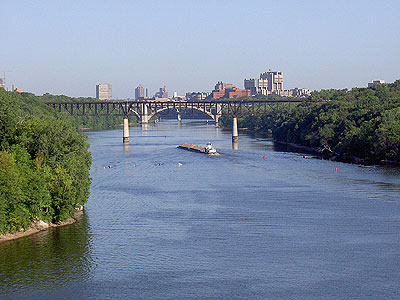
On Friday 7/7 I attempted to make a deposit at the Arden Hills Wells Fargo branch. I was depositing my wife's signed paycheck into our joint account using a deposit slip from our checkbook and requesting no money back. The teller and her supervisor (Suzanne?) refused to accept this because I was on a bicycle in the drive-through lane. I left. On Monday 7/10 I successfully made the deposit in the exact same branch from my bicycle. After posting this experience on my blog I got a lot of comments, some indicating no problem with doing this and others saying their Wells Fargo branch does not allow it. I would like to know the policy; is it company-wide, branch by branch or teller-dependent? I routinely ride my bicycle to work and have done this exact transaction before (see 6/2/06) without issue. Please let me know what to expect.Wells Fargo responded to the Messages and Alerts section of the account screen.
Thank you. Matt.
Dear Matt:Hmmm, so the decision is ultimately with the branch. I guess I'll have to go and inquire at the Arden Hills branch about what their policy is in relation to serving cyclists in the drive-throughs. I also wonder about Joyce's "with proper identification" qualification; in my email to Wells Fargo I was very specific about the nature of the transaction and it's one for which I have never had to provide ID since I'm not getting any money back. I even referred in my email to the last time I did this transaction from my bicycle so that if they were looking at the account they would see the same deposit amount from the prior month. The deposit would recur in the months previous but I can't be certain I did them from my bike on those dates.
I apologize that you experienced a problem when you attempted to make your deposit. With proper identification, there should be no problem in making the deposit as you described however, the decision is ultimately with the branch.
I have forwarded the details of your experience to our management. We constantly strive to provide you with the highest level of customer service.
We appreciate your business and thank you for banking with Wells Fargo.
Sincerely,
Joyce H
Wells Fargo
Online Customer Service


A bicycle bell tinkled and I looked up and saw a Dutchman in a knit cap coming toward me. As he pedaled by, a fuzzy white head popped up from his bike basket. It was a terrier, chin up, ears perked forward, head tilted curiously to one side. Easy-riding Rover, I thought. The dog was probably enjoying the moment as much as I was.Accompanying the article was a photo of a bike with either a Basil or Basil-like pet basket on it. It's worth looking at their site; they make lovely wire and wicker baskets and the pet carriers look particularly useful as they have a wire cage thing to go over the top and apparently mount to the seat tube rather than directly to the rear rack so (I think) the pooch or kitty doesn't get shaken to pieces. Not that I'd take Sophie the cat anywhere, but it's still cool. I emailed Basil to see if they sold here in the U.S., but not yet, apparently. I also emailed Jim at Hiawatha Cyclery encouraging him to tie up all his working capital in a container-load of these things so that maybe I could buy one if I felt like it. Sadly, he may be learning after his Bleriot enthusiasm.
Its master and I were bicycling through the countryside about 25 miles southwest of Am sterdam, watching Holland's famous flower fields flash by. The terrain was flat, the air crisp and clear, the scenery a splash of dazzling yellow and green. Acres of bright daffodils stretched in every direction. I felt as though I had found bicycle nirvana.
Perhaps I had. With 13 million bicycles, the Netherlands — or Holland, its regional name — has twice as many bikes as cars and nearly as many bicycles as people. An 11,000-mile system of bike paths, many of which are separate from highways, crisscrosses a nation so small and flat that it's easy to use bicycles to transport people, groceries, even terriers.
No wonder the general population gets annoyed with cyclists. Do those of us that use a bike for serious transportation a favor and quit making an ass of yourself.
It is up to each financial institution - no problem with regard to insurance.Then, ever on the job:
It's those pesky banks.....you should be using your fantastic Credit Union!!She's right, I should. We have savings accounts and a car loan at the credit union but not our primary checking. This is basically because of inertia.